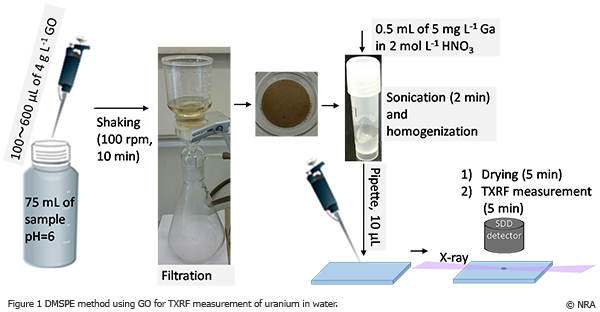A novel method for trace determination of uranium
 Uranium is an important nuclear material and contaminant with respect to the sites of uranium mining and whole nuclear facilities. As uranium can be released into the environment from these mining and facilities activities, it represents a typical actinide element, in various types of radioactive wastewater. Nuclear industries are thus point sources for potential release of uranium contaminated water into the environment.
Uranium is an important nuclear material and contaminant with respect to the sites of uranium mining and whole nuclear facilities. As uranium can be released into the environment from these mining and facilities activities, it represents a typical actinide element, in various types of radioactive wastewater. Nuclear industries are thus point sources for potential release of uranium contaminated water into the environment.
Some analytical methods, such as inductively coupled plasma-mass spectrometry (ICP-MS), spectrophotometry, alpha spectrometry, and laser fluorometry, are available for the determination of low-level concentrations of uranium in various matrices. In most cases, complicated pretreatment methods are needed or high-cost instrumentation installed in a laboratory is necessary. Among them, alpha-spectrometry has been frequently applied to the determination of long-lived alpha-emitters. Since uranium has lower alpha specific activity than the other actinides, a larger amount of samples or longer counting time are needed for adequate detection.
Total reflection X-ray fluorescence (TXRF) spectrometry is a suitable method for determining uranium in liquid samples by using U L X-ray lines when uranium is separated from rubidium. Recently, graphene-based materials, which are new carbon-based materials that are of interest in separation science, are used in dispersive micro-solid phase extraction (DMSPE) to measure trace metal ions. Graphene has extraordinary properties, including nano size, high surface area, thermal and chemical stability, and excellent adsorption affinity to metal ions. These properties have led to graphene-based material becoming a desirable adsorbent in a popular sample preparation technique known as DMSPE. Numerous studies have been published on graphene applications, but, to the best of our knowledge, no papers have focused on its applications in uranium measurement.
A novel method for trace determination of uranium has been developed in this study[[i]]. As shown in Figure 1 the method is the TXRF spectroscopy following the DMSPE using graphene oxide (GO). The proposed DMSPE method using GO with a preconcentraion factor of 150 provided removal of the interference peak of Rb Kα and high uranium recoveries. The adsorption time using GO was much shorter than conventional adsorbents. The uranium detection limits were 0.042, 0.087, and 0.12 µg L-1 for ionic strength of 0.01, 0.1 and 1 mol L-1, respectively. Such low detection limits were obtained by using a benchtop TXRF spectrometer with 5 min measurement. The proposed methodology allows obtaining rapid determination, high recovery, high enrichment factor and low detection limit of uranium in water, including high salinity samples that are difficult to analyze using other spectroscopy techniques.
Hiroaki Takahashi
Regulatory Standard and Research Department, Secretariat of Nuclear Regulation Authority, Japan
hiroaki_takahashi@nsr.go.jp